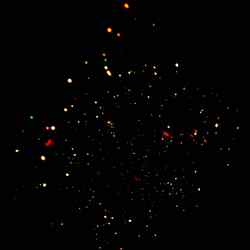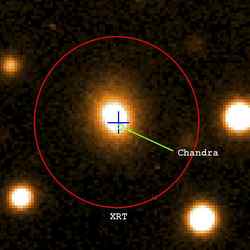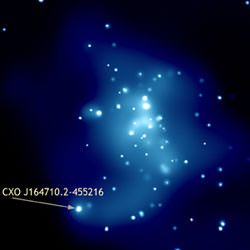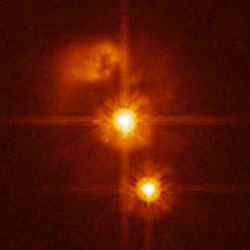The supermassive black holes thought to be lurking at the heart of most galaxies could create such a hostile environment around them that they prevent the formation of new stars. This is according to new research assisted by NASA’s Galaxy Evolution Explorer (GALEX). The space-based telescope observed more than 800 galaxies, and found that the larger galaxies had fewer young stars. Astronomers believe that jets blasting out of supermassive black holes could clear out gas and dust; potential star forming material.
Continue reading “Supermassive Black Holes Prevent Star Formation”
The Search for Hidden Black Holes
Look into the sky with X-ray instruments, and you’ll see a background radiation in all directions. Astronomers think these X-rays are produced by the supermassive black holes at the centres of most galaxies. But astronomers can’t find these black holes, which should be bright in the most energetic range of the electromagnetic spectrum. Maybe they’re hiding; shrouded in thick clouds of gas and dust. Or maybe something else is generating all the X-ray background radiation.
Continue reading “The Search for Hidden Black Holes”
A New View of Quasars
Some of the brightest objects in the Universe are quasars. A mystery for decades, most astronomers now believe quasars are the bright centres of galaxies with actively feeding supermassive black holes. A team of researchers have found evidence that there might be something very different at the heart of these galaxies to cause quasars. Instead of black holes consuming matter, there could be objects with powerful magnetic fields that act like propellers, churning matter back into the galaxy.
Continue reading “A New View of Quasars”
Magnetic Fields Help Black Holes Pull In Matter
Even though the gravity from black holes is so strong that light can’t even escape, we can see the radiation from the superheated matter that’s about to be consumed. Until now, scientists haven’t been able to explain how all this matter continuously falls into the black hole – it should just orbit, like planets going around a star. New data from the Chandra X-Ray Observatory shows that a black hole’s powerful magnetic field creates a turbulence in surrounding matter that helps drive it inward to be consumed.
Continue reading “Magnetic Fields Help Black Holes Pull In Matter”
Everything’s on the Menu for Supermassive Black Holes
The supermassive black holes that lurk at the heart of most galaxies have enormous appetites. They’ve already consumed millions of times the mass of our own Sun, and they’re not done yet. Everything’s on the menu: mostly gas, dust, planets and stars, but the occasional exotic delicacy gets consumed too. “Compact objects”, such as stellar mass black holes, neutron stars, and white dwarfs occasionally fall into their grasp too. But these objects don’t go with a whimper; they make screams we’ll soon hear across intergalactic space.
Continue reading “Everything’s on the Menu for Supermassive Black Holes”
Podcast: Dark Energy Stars
Black holes… you know. Cosmic singularities that can contain the mass of billions of stars like our Sun. Where the pull of gravity is so strong, nothing, not even light can escape their fearsome grasp. They’re the source of much discussion, indirect observation and science fiction speculation. But according to George Chapline from Lawrence Livermore National Laboratory in California, they don’t exist. Instead we have dark energy stars, which are connected to that mysterious force accelerating the expansion of the Universe.
Continue reading “Podcast: Dark Energy Stars”
The Sky is Full of Black Holes

X-ray image of the Chandra Deep Field-North. Image credit: NASA/PSU Click to enlarge
Data from X-ray observatory surveys show that black holes are much more numerous and evolved differently than researchers would have expected, according to a Penn State astronomer.
“We wanted a census of all the black holes and we wanted to know what they are like,” said Niel Brandt, professor of astronomy and astrophysics. “We also wanted to measure how black holes have grown over the history of the Universe.”
Brandt and other researchers have done just that by looking at a patch of sky in the Northern hemisphere called the Chandra Deep Field-North, using NASA’s Chandra X-ray Observatory and a similar patch in the Southern hemisphere called the Extended Chandra Deep Field-South. Surveys also are being carried out in other parts of the sky using both Chandra and the European Space Agency’s X-ray Multi-Mirror Mission-Newton.
The researchers looked at X-ray emissions because areas around black holes emit X-rays as well as visible light. The penetrating nature of X-rays provides a direct way to identify the black holes. Using X-rays also enables astronomers to pinpoint the black holes at the centers of galaxies without their signal being washed out by the visible light coming from a galaxy’s stars, Brandt told attendees at the annual meeting of the American Association for the Advancement of Science in St. Louis, Mo. Feb. 17. The black holes they studied were those that reside at the centers of galaxies and are actively emitting X-rays, therefore they are called active galactic nuclei.
“We find active super massive black holes at the centers of massive galaxies,” said Brandt. “Our galaxy also has its own black hole at its center measuring 2.6 million solar masses. Our black hole is not active today, but we presume it was active in the past.”
These deep, extragalactic X-ray surveys looked at carefully chosen patches of sky, that are largely free of anything that might interfere with obtaining the X-ray data. Chandra looked at the Chandra Deep Field-North — an area of sky two thirds the size of the full Moon — for the time span of 23 days over a two-year period. The researchers detected about 600 X-ray sources. After comparing the X-ray images with optical images of exactly the same slice of sky taken by the Hubble Space Telescope, nearly all 600 point sources corresponded to optical galaxies, suggesting that the black holes that were sources for the X-ray signature were in the centers of galaxies.
“X-ray astronomers are doing better than anyone else by about a factor of ten, in identifying these active galactic nuclei” said Brandt. “With more time we could do even better, going even deeper.”
What the researchers found was that super massive black holes are more numerous than we might have expected. They also found that black holes evolved differently than astronomers expected prior to the Chandra work. Extrapolating from the 600 black holes found by Chandra, Brandt suggests that there are about 300 million super massive black holes in the whole sky.
The existence of so many black holes, confirmed that what was once thought to be a truly diffuse cosmic X-ray background radiation, actually comes from point sources.
In the 1960s, astronomers discovered quasars, very distant, highly luminous black holes, in galactic centers. Quasars, initially called quasi-stellar radio sources, were studied intensely. Researchers soon realized that only some of these objects were radio emitters and that they formed early in the history of the Universe.
“While quasars are spectacular, they are not representative of typical active galactic nuclei,” said Brandt. “Now, using Chandra and other X-ray observatories, we can find and study the moderate-luminosity, typical active galactic nuclei in the distant, high-redshift Universe.”
Quasars and moderate-luminosity active galactic nuclei also evolved differently. Quasars are a phenomenon of young galaxies, while moderate-luminosity, active galactic nuclei peaked later in cosmic time.
“We would like to know if active galactic nuclei change over cosmic time,” said Brandt. “Do black holes feed and grow in the same way over the history of the Universe?”
Researchers looked at the relative amount of power coming out in X-rays compared to other wavelengths and found that this ratio does not change over 13 billion years of time. They looked at the X-ray spectra and found that these also did not change through time.
“Despite the enormous changes in the space density of back holes, the individual engines powering active galactic nuclei are remarkably stable,” Brandt said.
Brandt believes that Chandra could observe the Chandra Deep Field-North for a longer period of time and obtain more sensitive, deeper data. This would bring to light galaxies that are currently obscured. It would also gather more X-rays allowing better X-ray spectral and variability analyses. With more sensitive probing, the researchers are also detecting an increasing number of non-active galaxies like our own.
“Chandra has worked well for six years now,” said Brandt. “There is no reason why Chandra and Newton cannot continue to observe for another 10 or more years.”
Original Source: PSU News Release
Black Hole Gulps Down a Neutron Star

Gamma-Ray Burst GRB 050724. Image credit: ESO Click to enlarge
An international team of astronomers reports the discovery of a third short gamma-ray burst, associated with a nearby elliptical galaxy. The low level of star formation in such galaxies and the detection of a second long-lasting flare indicate that this gamma-ray burst is most likely the final scream of a neutron star as it is being devoured by a black hole.
Gamma-ray bursts (GRBs), the most powerful type of explosion known in the Universe, come in two different flavours, long and short ones. Over the past few years, international efforts have shown that long gamma-ray bursts are linked with the ultimate explosion of massive stars (hypernovae).
Very recently, the observations by different teams – including the GRACE and MISTICI collaborations that use ESO’s telescopes – of the afterglows of two short gamma-ray bursts provided the first conclusive evidence that this class of objects originates most likely from the collision of compact objects, neutron stars or black holes.
On July 24, 2005, the NASA/PPARC/ASI Swift satellite detected another short gamma-ray burst, GRB 050724. Subsequent observations, including some with the ESO Very Large Telescope, allowed astronomers to precisely pinpoint the position of the object, lying about 13,000 light-years away from the centre of an elliptical galaxy that is located 3,000 million light-years away (redshift 0.258).
“From its characteristics, we infer that this galaxy contains only very old stars,” says Guido Chincarini (INAF-Brera and Milan University, Italy), co-author of the paper presenting the results. “This is similar to the host galaxy of the previous short GRB which could be precisely localised, GRB 050509B, and very different from host galaxies of long bursts.”
These observations thereby confirm that the parent populations and consequently the mechanisms for short and long GRBs are different in significant ways. The most likely scenario for short GRBs is now the merger of two compact objects.
The observations also show this short burst has released between 100 and 1000 less energy than typical long GRBs. “The burst itself was followed after about 200-300 seconds by another, less-energetic flare,” says Sergio Campana (INAF-Brera), co-author of the paper. “It is unlikely that this can be produced by the merger of two neutron stars. We therefore conclude that the most probable scenario for the origin of this burst is the collision of a neutron star with a black hole.”
Original Source: ESO News Release
That Neutron Star Should Be a Black Hole

Westerlund 1 star cluster. Image credit: Chandra. Click to enlarge.
A very massive star collapsed to form a neutron star and not a black hole as expected, according to new results from NASA’s Chandra X-ray Observatory. This discovery shows that nature has a harder time making black holes than previously thought.
Scientists found this neutron star — a dense whirling ball of neutrons about 12 miles in diameter — in an extremely young star cluster. Astronomers were able to use well-determined properties of other stars in the cluster to deduce that the progenitor of this neutron star was at least 40 times the mass of the Sun.
“Our discovery shows that some of the most massive stars do not collapse to form black holes as predicted, but instead form neutron stars,” said Michael Muno, a UCLA postdoctoral Hubble Fellow and lead author of a paper to be published in The Astrophysical Journal Letters.
When very massive stars make neutron stars and not black holes, they will have a greater influence on the composition of future generations of stars. When the star collapses to form the neutron star, more than 95% of its mass, much of which is metal-rich material from its core, is returned to the space around it.
“This means that enormous amounts of heavy elements are put back into circulation and can form other stars and planets,” said J. Simon Clark of the Open University in the United Kingdom.
Astronomers do not completely understand how massive a star must be to form a black hole rather than a neutron star. The most reliable method for estimating the mass of the progenitor star is to show that the neutron star or black hole is a member of a cluster of stars, all of which are close to the same age.
Because more massive stars evolve faster than less massive ones, the mass of a star can be estimated from if its evolutionary stage is known. Neutron stars and black holes are the end stages in the evolution of a star, so their progenitors must have been among the most massive stars in the cluster.
Muno and colleagues discovered a pulsing neutron star in a cluster of stars known as Westerlund 1. This cluster contains a hundred thousand or more stars in a region only 30 light years across, which suggests that all the stars were born in a single episode of star formation. Based on optical properties such as brightness and color some of the normal stars in the cluster are known to have masses of about 40 suns. Since the progenitor of the neutron star has already exploded as a supernova, its mass must have been more than 40 solar masses.
Introductory astronomy courses sometimes teach that stars with more than 25 solar masses become black holes — a concept that until recently had no observational evidence to test it. However, some theories allow such massive stars to avoid becoming black holes. For example, theoretical calculations by Alexander Heger of the University of Chicago and colleagues indicate that extremely massive stars blow off mass so effectively during their lives that they leave neutron stars when they go supernovae. Assuming that the neutron star in Westerlund 1 is one of these, it raises the question of where the black holes observed in the Milky Way and other galaxies come from.
Other factors, such as the chemical composition of the star, how rapidly it is rotating, or the strength of its magnetic field might dictate whether a massive star leaves behind a neutron star or a black hole. The theory for stars of normal chemical composition leaves a small window of initial masses – between about 25 and somewhat less than 40 solar masses – for the formation of black holes from the evolution of single massive stars. The identification of additional neutron stars or the discovery of black holes in young star clusters should further constrain the masses and properties of neutron star and black hole progenitors.
The work described by Muno was based on two Chandra observations on May 22 and June 18, 2005. NASA’s Marshall Space Flight Center, Huntsville, Ala., manages the Chandra program for the agency’s Science Mission Directorate. The Smithsonian Astrophysical Observatory controls science and flight operations from the Chandra X-ray Center in Cambridge, Mass.
Additional information and images are available at: http://chandra.harvard.edu
and http://chandra.nasa.gov
Original Source: Chandra News Release
Rogue Supermassive Black Hole Has No Galaxy

Hubble image from a sample of 20 nearby quasars. Image credit: NASA/ESA/ESO Click to enlarge
The detection of a super-massive black hole without a massive ‘host’ galaxy is the surprising result from a large Hubble and VLT study of quasars.
This is the first convincing discovery of such an object. One intriguing explanation is that the host galaxy may be made almost exclusively of ‘dark matter’.
A team of European astronomers has used two of the most powerful astronomical facilities available, the NASA/ESA Hubble Space Telescope and the ESO Very Large Telescope (VLT) at Cerro Paranal, to discover a bright quasar without a massive host galaxy.
Quasars are powerful and typically very distant source of huge amounts of radiation. They are commonly associated with galaxies containing an active central black hole.
The team conducted a detailed study of 20 relatively nearby quasars. For 19 of them, they found, as expected, that these super-massive black holes are surrounded by a host galaxy. But when they studied the bright quasar HE0450-2958, located some 5000 million light-years away, they could not find evidence for a host galaxy.
The astronomers suggest that this may indicate a rare case of a collision between a seemingly normal spiral galaxy and an ‘exotic’ object harbouring a very massive black hole.
With masses that are hundreds of millions times bigger than the Sun, super-massive black holes are commonly found in the centres of the most massive galaxies, including our own Milky Way. These black holes sometimes dramatically manifest themselves by devouring matter that they gravitationally swallow from their surroundings.
The best fed of these objects shine as ‘quasars’ (standing for ‘quasi-stellar object’ because they had initially been thought of as stars).
The past decade of observations, largely with the Hubble telescope, has shown that quasars are normally associated with massive host galaxies. However, observing the host galaxy of a quasar is challenging work because the quasar completely outshines the host and masks the galaxy?s underlying structure.
To overcome this problem, the astronomers devised a new and highly efficient strategy. Combining Hubble?s ultra-sharp images and spectroscopy from ESO?s VLT, they observed their sample of 20 quasars at the same time as a reference star. The star served as a reference pinpoint light source that was used to disentangle the quasar light from any possible light from an underlying galaxy.
Despite the innovative techniques used, no host galaxy was seen around HE0450-2958. This means that if any host galaxy exists, it must either be at least six times fainter than typical host galaxies, or have a radius smaller than about 300 light-years, i.e. 20 to 170 times smaller than typical host galaxies (which normally have radii ranging from about 6000 to 50 000 light-years).
“With the powerful combination of Hubble and the VLT we are confident that we would have been able to detect a normal host galaxy,” said Pierre Magain of the Universit? de Li?ge, Belgium.
The astronomers did however detect an interesting smaller cloud of gas about 2500 light-years wide near the quasar, which they call ‘the blob’. VLT observations show this cloud to be glowing because it is bathed in the intense radiation coming from the quasar, and not from stars inside the cloud. Most likely, it is the gas from this cloud that feeds the super-massive black hole, thereby allowing it to become a quasar.
“The absence of a massive host galaxy, combined with the existence of the blob and the star-forming galaxy, lead us to believe that we have uncovered a really exotic quasar,” said Fr?d?ric Courbin of the Ecole Polytechnique Federale de Lausanne, Switzerland.
“There is little doubt that an increase in the formation of stars in the companion galaxy and the quasar itself have been ignited by a collision that must have taken place about 100 million years ago. What happened to the putative quasar host remains unknown.”
HE0450-2958 is a challenging case. The astronomers propose several possible explanations. Has the host galaxy been completely disrupted as a result of the collision? Has an isolated black hole captured gas while crossing the disk of a spiral galaxy? This would require very special conditions and would probably not have caused such a tremendous disturbance of the neighbouring galaxy as is observed. Further studies will hopefully clarify the situation.
Another intriguing hypothesis is that the galaxy harbouring the black hole was almost exclusively made of ‘dark matter’. It may be that what is observed is a normal phase in the formation of a massive galaxy, which in this case has taken place several 1000 million years later than in most others.
Original Source: ESA Portal
